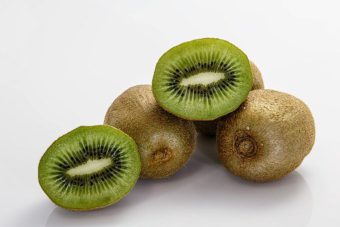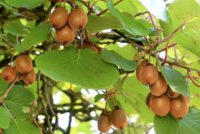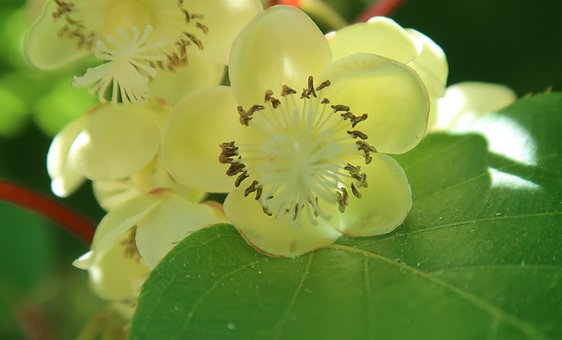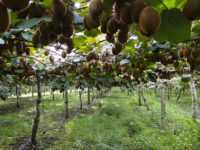In this article, we will be discussing how to grow kiwi in containers, so that you can have an abundance of fruit throughout the autumn months.
This plant is a beautiful climbing vine that would have been cultivated even if it does not produce its delicious fruits.
What you will discover is that this exotic fruit is not a difficult plant to grow, if you get all the growing conditions right.
The plant has pointed, heart-shaped leaves that are rich in colour and leaf stalks that are red marked, whilst young. In summer, wonderfully scented, white flowers are produced.
FROM CHINESE GOOSEBERRY TO KIWIS

The fruit was initially known as Chinese gooseberry because they originated from China, but because of the developments made by New Zealand horticulturists in developing new breeds, it has been known as Kiwi fruits. It has become an important commercial fruit there. It is botanically known as Actinidia delicosa, part of the ornamental range of the Actinidia family, often found in gardens.
The fruit that is produced looks uninviting but they are delicious, juicy, tangy fruit and well worth trying at home. To grow kiwi effectively you need 2 plants- a male and a female, but now self-fertile varieties have been developed, so you can get away by having one plant.
The biggest problem is that they do take over your garden, so you do need space to grow it in. This is because the twin, twining stems that readily romps away needs support to scramble over. It must be grown in a sunny position so that the plant can be induced to flower and to help the fruits to ripen quickly.
KIWI IN CONTAINERS
To plant in a container, you need to purchase a 60-litre pot that has drainage holes at the bottom. You can place two plants per container, one male, one female, but if you do this, you have to have a large container to do well.
Purchase some multipurpose compost, make sure that 1/3 is made out of organic matter, such as peat. You will then need to make your growing media by combining equal parts of multipurpose compost, perlite, and vermiculite. Mix it well.
Add a granular fertilizer such as Q4 fertilizers on the quantities recommended by the manufacture and then mix it well. The growing media is then ready to use in the container to grow the kiwi.
Place the container next to a trellis, arbour or pergolas, so that the twines can grow up them.
THE METHOD TO USE

Fill the container with 2/3 full of the prepared growing media. If you are using a self-fertile kiwi plant, remove from its container that it comes with, place it in the centre of the container, making sure the bottom portion of the root ball is placed on top of the compost. Add more growing media until the plant is covered to the level it was in the original container.
If you are planting a male and female plants, remove them from their containers and put them side by side in the same container. Add more growing media to bring the compost up to the level of the top of the plants and then firm it into place to get rid of air gaps. Water well to allow the compost to settle.
Place a stake next to the newly planted vine if necessary to lead it to a trellis, pergolas or arbours. As it grows use plant string to fasten the vine to the stake at intervals. Eventually, the plant will twine up the support on its own, but you may need to tie them in to offer better support.
Grow them in a warm, sunny, sheltered spot.
HOW TO CARE FOR KIWI
In early spring, mulch generously and sprinkle a handful of granular feed, such as fish, blood and bone and add a scoop of sulphate of potash over the compost, and then fork it in. You need to pay particular attention to pruning (see later on how to do this).
The site that is chosen should ideally be free of late frosts, but special attention should be given to them in the spring when they produce leaves. They are highly susceptible to damage by late frosts when they are coming into leaf. This can set them back for a whole season. If a late frost is forecasted protect them with horticultural fleece wrapped around the whole plant.
They are hardy plants, can take temperature as low as -8 degree Celsius. Any lower and it can kill the plants. If during winter, a severe frost is predicted, you need to wrap the vine in bubble wrap. If you live in a cold area of the UK, it is advised to use bubble wrap to protect your plant anyway.
Vines will do better in a greenhouse where they are reliable croppers, as long as hand pollination takes place, as no insects will be present to do it for you.
POLLINATING THE FLOWERS

The white, scented, cup-shaped flowers open in early summer, where the bees and hoverflies are attracted into pollinating the female flowers.
To add pollination and fruit set, it may be advised to pick up pollen from male flowers by using a fine artist brush and then bring them to the females, one by one. One male flower can pollinate up to 8 female flowers. This should be done when the male flower is less than 3 days old, where female flowers are more receptive.
All male varieties will pollinate all the different female varieties, although the female varieties can vary slightly in the times at which they flower. Males have quite an extended season and will almost always catch the females.
Self-fertile varieties are coming on the market. They will produce fruit if you have the room to grow them, but you will not see the greatest crop or the best quality fruit. If you want the best you need a male and female plant.
To keep them happy by providing a strong framework or trellis of wire to grow on and train them properly. You must tie in new growth regularly during the summer. In spring, as said earlier feed and mulch to keep the plants happy throughout the growing season.
PRUNING AND TRACKING
Kiwi is best trained on horizontal wires and where the gap between each wire is 30 to 40cm apart. It is best to train as an espalier.

The aim is to create many tiers of horizontal stems that will carry fruiting spurs. The vines need frequent tying in, as they grow very quickly, but this must be done after the new shoots have hardened enough not to break when it is bent into position. Tie the stems to the supports and do not attempt to twine them, as stems can be broken.
Prune in late winter to early spring, once the risk of severe frost has passed. They may be some bleeding, but this does not seem to harm the plant. The idea is to continually replace shoots that are older than three to four years.
If you do not have room for many kiwi fruit plants as said early, you need to plant both male and females in the same container. You need to train both plants in the same way, but have one upright stem for each plant and train alternate male and female stems out along the wires.
HOW TO TRAIN KIWI FRUIT
During the winter after planting or soon after planting cut the main growing stem back to about 30cm high and remove any other side shoots that are competing with it.

The following year, as new growth starts, select the three strongest shoots. Tie one shoot to the main cane supporting the plants to keep as the main stem. Train the other two horizontally along the wires, one to the left and one to the right. Any other shoots growing from the three stems need to be removed.
In summer, prune the lateral back to 90cm. Allow sub-laterals to develop on them at 50cm intervals, and cut these back to 5 leaves to form fruiting spurs. If suitable lateral appear higher up the main stem, train them horizontally on the next wire.
The next summer, after cutting back the main stem to the wire above the top laterals, select the strongest shoots from the next tier of laterals. On these, allow fruiting shoots to form and prune these as on the lower laterals. Continue each year until the desired size is reached.
HOW TO MAINTAIN KIWI FRUITS
In summer, shorten sub-laterals all to five leaves beyond the fruit. Cut back any unproductive stems to 5 leaves and any new plants growing around the fruiting spurs to seven leaves.
In midwinter, prune fruiting shoots to two or three buds beyond the point where the last fruit was borne. On older twines, cut back three-year-old fruiting shoots to a dormant bud for new shoots at the base.
ENJOY THEM
In October or later, if it has been a poor summer. Pick one or two to try- they should be softly firm and taste sweet. If an early frost is being broadcasted, then drop fleeces over plants, so the fruit can continue to ripen.
Sometimes you get an excessive crop that you may need to thin them to maintain a good, quality of fruit. This will not only encourage better fruit size but ensures that you will get better crops the following year. Up to 1/3 of the fruit can be removed to help in this regard.
The fruits, as said earlier must be left as long as possible on the vine, and it will not ripen naturally unless a prolonged, warm autumn has occurred.
As most fruit would not be fully ripe when you harvest them the next best thing is to ripen them on a sunny windowsill.
The fruit is ripe when it gives slightly under gentle pressure from thumb and forefinger.
A large number of fruits can be stored ideally in a refrigerator and brought out into a sunny windowsill for ripening, a few at a time.
An alternative is to align them in a single layer in trays in a cool garage or shed, where they should keep for up to 6 weeks.
The flavour will also continue to develop.
The most likely problem is small fruits that do not ripen. It is usually due to the plant being cold or receiving too little sun. Under these conditions, it is better to grow them in a greenhouse.
VARIETIES TO GROW
‘Abbott’ and ‘Bruno’- Both are heavy croppers, each needs pollinating partners. Bruno is slightly larger.
‘Jenny’ is a semi-fertile with small, very sweet fruit, but it is not very hardy.
‘Heywood’ is a late flowering variety that is not over-vigorous.
‘Alatis’ is the best male plant to grow, pollinating all-female varieties. It is vigorous growing and hardy.
CONCLUSION
In this article, we have discussed all aspects that need to be considered to grow kiwis in containers. We have discussed how to plant them, how to care for them, how to train and prune them and the best varieties to grow.
They are not a difficult crop to grow, all they need is training, pruning and thinning of fruits, then you can be harvesting succulent fruits in the near future.
If you have any questions or comments, please do so in the comment box below.
Make kiwi your fruit of choice this season.

Hi,
Very good article, the information on the cultivation of the kiwi is of quality, the teaching proceeding step by step to be able to achieve the objective and cultivate the kiwis in a container
Kiwi is a fruit with many vitamins
You undoubtedly know that kiwi is a fruit rich in vitamin C, but did you know that it has more than twice an orange? Consuming 2 kiwis a day we fully cover our daily vitamin C needs!
Hi Walter
I am glad you enjoy the article. I try to be as informative as possible in the shortest of time possible. I never knee that kiwi fruits contain that much vitamin C and the flavour is outstanding as well. I do hope you grow a variety or two.
Thanks
Antonio
Who knew there are male and female kiwi. I should have known but kiwi have not been high in my consciousness until now. My wife called while baby sitting grandkids (actually most of them are old enough now it more like refereeing. Arguing over the X-Box Controller.
I told her I was reading a fascinating article about growing kiwi in a (bucket … American directness) container. She thought it sounded fascinating too. So with two plants in a “container” and all proper care taken, how many kiwi’s do you get to harvest per season. Rough estimate, you know, unless you have a database.
I want you to know I have truly been enjoying the reading in your posts. You write well. I like the images too, that one right there is making me want to go get kiwi. You definitely engaged me with your writing style. And the subject is very pertinent and people really need to consider growing their own food as a just in case. Thank you for posting this. Chris.
Hi ChrisQueen
Thank you very much for stopping by and commenting on Kiwis, one of my favourite fruit. I believe in when writing an article to be detailed as possible so that people can make an informed decision. To answer your question is a lot probably 100 plus but you have to thin to get quality. You will probably have more than enough.
Kind regards
Antonio
Hi Antonio.
The thought of growing Kiwis to harvest and eat is wonderful. We live in the UK and I don’t think we have the climate for these lovely fruits to grow, having said that my wife does have a kiwi plant in the garden in a big tub, it has grown to a fair size and looks nice but has never produced anything maybe that’s because it is just one plant and not the male/female planting you talked about?
15 Years ago we visited Croatia in the summer, it was bright and hot all year round and these lovely fruits were hanging from trees in the streets, the local people took them for granted but we were amazed and picked and ate many.
Thank you for an interesting read that took me away to warm sunny destinations.
Mike
Hi Mike
I am glad my article has took you back to that beautiful holiday destination in Croatia, a place I would like to grow. I am sure that your wife has probably bought a self fertile one as often this is the one variety sold in the shops but you have to wait and see if it produces. Training and pruning is important as she maybe not pruning right and hence not getting fruiting spurs.
All the best
Antonio